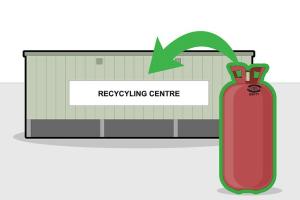Ultimate Guide to Safely Dispose of a Helium Tank: Step-by-Step Instructions

-
Quick Links:
- Introduction
- Understanding Helium Tanks
- Safety Precautions
- Disposal Options for Helium Tanks
- Step-by-Step Guides for Disposal
- Recycling Helium Tanks
- Case Studies and Real-World Applications
- Expert Insights
- FAQs
- Conclusion
Introduction
Helium tanks are commonly used for various purposes, including balloon inflation, scientific experiments, and even medical applications. However, when you are done with a helium tank, proper disposal is crucial to ensure safety and environmental protection. This comprehensive guide will walk you through the process of safely disposing of a helium tank, providing step-by-step instructions, safety precautions, and alternative disposal options.
Understanding Helium Tanks
Helium tanks come in various sizes and types, typically made of aluminum or steel. They are pressurized containers that store helium gas, a non-toxic, non-flammable, and lighter-than-air element. While helium itself poses minimal risk, improper disposal of helium tanks can lead to hazardous situations, including explosions or environmental contamination.
Types of Helium Tanks
- Small Portable Tanks: Commonly used for balloon decoration and small events.
- Large Industrial Tanks: Used for scientific and industrial applications, often requiring specialized handling.
- Disposable Tanks: Smaller, one-time-use tanks that can be tricky to dispose of properly.
Safety Precautions
Before disposing of a helium tank, it’s essential to take the following safety precautions:
- Always wear protective gear, such as gloves and goggles.
- Ensure the tank is empty before disposal. You can either use the helium until it runs out or follow specific steps to release the gas safely.
- Store the tank in a well-ventilated area away from heat sources.
- Do not attempt to puncture or incinerate the tank.
Disposal Options for Helium Tanks
There are several methods for disposing of a helium tank, each with its advantages and disadvantages:
- Return to Supplier: Many suppliers offer a take-back program for used tanks.
- Local Recycling Centers: Check if your local recycling center accepts helium tanks.
- Hazardous Waste Collection: Some municipalities have special collection days for hazardous materials.
- Professional Disposal Services: Hiring a professional service can ensure safe and compliant disposal.
Step-by-Step Guides for Disposal
Step 1: Empty the Tank
To safely dispose of your helium tank, you first need to ensure that it is empty. Follow these steps:
- Attach a balloon or a similar item to the nozzle.
- Release the helium slowly to avoid a rapid depressurization.
- Continue until you can no longer inflate additional balloons.
Step 2: Determine Disposal Method
Choose one of the disposal options listed above based on your tank size and local regulations.
Step 3: Transport the Tank
Ensure that the tank is secured during transport. If using a vehicle, place it upright and secure it to prevent movement.
Step 4: Dispose Responsibly
Follow the chosen method's guidelines to ensure safe disposal. If returning to a supplier or recycling center, confirm their procedures in advance.
Recycling Helium Tanks
Recycling helium tanks is an environmentally friendly option that helps conserve resources. Here’s how to find recycling options:
- Contact local recycling centers to inquire if they accept helium tanks.
- Look for specialized recycling programs in your area.
- Check with the manufacturer for any recycling initiatives.
Case Studies and Real-World Applications
Understanding real-world applications can help solidify your knowledge about helium tank disposal.
Case Study 1: City of San Francisco
In 2022, the City of San Francisco launched a program to educate residents on the proper disposal of helium tanks, reducing environmental impact by 30% within the first year.
Case Study 2: Environmental Organizations
Environmental groups have reported that educational outreach on helium tank disposal can significantly decrease hazardous waste incidents.
Expert Insights
Experts recommend community workshops to raise awareness and provide hands-on guidance for proper disposal techniques. Engaging with local businesses to promote responsible disposal practices can foster community responsibility.
FAQs
1. Can I throw my helium tank in the regular trash?
No, helium tanks are typically considered hazardous waste and should not be thrown in the regular trash.
2. How do I know if my helium tank is empty?
When you can no longer inflate balloons or feel pressure from the nozzle, the tank is likely empty.
3. Are there any recycling programs for helium tanks?
Many local recycling centers may accept helium tanks; check with them for specific guidelines.
4. What should I do if the tank is damaged?
If your tank is damaged, contact a professional disposal service for guidance on handling it safely.
5. Can I use a helium tank for multiple events?
Yes, helium tanks can be reused for multiple events as long as they are not expired and remain in good condition.
6. Is it safe to release helium into the atmosphere?
While helium is non-toxic, it is recommended to dispose of it responsibly rather than releasing it into the atmosphere.
7. How should I transport a helium tank for disposal?
Always transport the tank upright, secured in your vehicle, and avoid direct sunlight or heat sources.
8. What is the environmental impact of improper disposal?
Improper disposal can lead to hazardous waste situations and contribute to environmental pollution.
9. Are there any specific regulations for helium tank disposal?
Yes, regulations vary by location. Check with local authorities for specific disposal guidelines.
10. Can I donate my helium tank?
If the tank is still full and in good condition, you may consider donating it to local event organizers or schools.
Conclusion
Proper disposal of helium tanks is essential for safety and environmental considerations. By following this guide, you can ensure that your helium tank is disposed of responsibly. Whether you choose to return it to a supplier, recycle it, or use a professional disposal service, the key is to prioritize safety and environmental stewardship.
For more information on safe disposal practices, refer to resources from the Environmental Protection Agency (EPA) at https://www.epa.gov and the Occupational Safety and Health Administration (OSHA) at https://www.osha.gov.
Random Reads